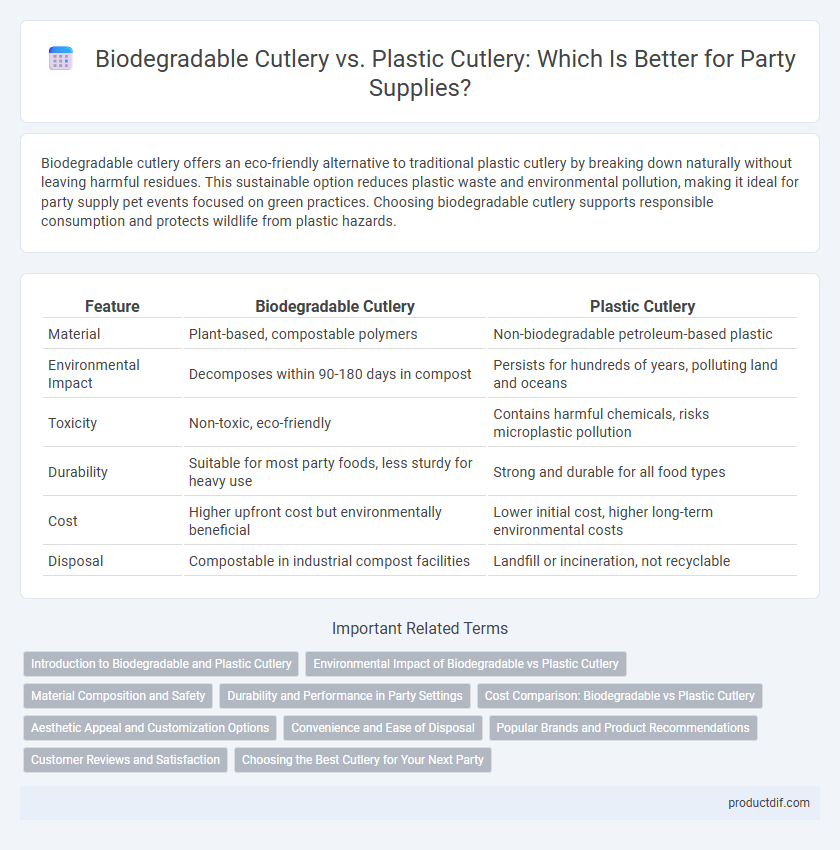Biodegradable cutlery offers an eco-friendly alternative to traditional plastic cutlery by breaking down naturally without leaving harmful residues. This sustainable option reduces plastic waste and environmental pollution, making it ideal for party supply pet events focused on green practices. Choosing biodegradable cutlery supports responsible consumption and protects wildlife from plastic hazards.
Table of Comparison
| Feature | Biodegradable Cutlery | Plastic Cutlery |
|---|---|---|
| Material | Plant-based, compostable polymers | Non-biodegradable petroleum-based plastic |
| Environmental Impact | Decomposes within 90-180 days in compost | Persists for hundreds of years, polluting land and oceans |
| Toxicity | Non-toxic, eco-friendly | Contains harmful chemicals, risks microplastic pollution |
| Durability | Suitable for most party foods, less sturdy for heavy use | Strong and durable for all food types |
| Cost | Higher upfront cost but environmentally beneficial | Lower initial cost, higher long-term environmental costs |
| Disposal | Compostable in industrial compost facilities | Landfill or incineration, not recyclable |
Introduction to Biodegradable and Plastic Cutlery
Biodegradable cutlery is made from natural materials such as cornstarch, bamboo, or sugarcane, designed to break down quickly in composting conditions, reducing environmental impact. Plastic cutlery, typically produced from petroleum-based plastics like polystyrene or polypropylene, offers durability and low cost but contributes significantly to long-term pollution and landfill waste. The choice between biodegradable and plastic cutlery plays a crucial role in sustainable party supplies and waste management strategies.
Environmental Impact of Biodegradable vs Plastic Cutlery
Biodegradable cutlery significantly reduces environmental pollution by breaking down naturally within months, unlike plastic cutlery which can persist for centuries in landfills and oceans. The production of biodegradable options often uses renewable resources, decreasing reliance on fossil fuels and reducing greenhouse gas emissions. Switching to biodegradable cutlery supports sustainable waste management and minimizes the harmful effects of plastic pollution on wildlife and ecosystems.
Material Composition and Safety
Biodegradable cutlery is primarily made from plant-based materials such as cornstarch, PLA (polylactic acid), or bamboo, which decompose naturally and reduce environmental impact. Plastic cutlery is typically manufactured from petroleum-based polymers like polystyrene or polypropylene, which are non-biodegradable and can release harmful chemicals over time. In terms of safety, biodegradable options are free from toxic additives and are less likely to leach harmful substances during use, making them safer for food contact and human health.
Durability and Performance in Party Settings
Biodegradable cutlery offers sufficient durability for most party settings, resisting breakage during typical use while being eco-friendly. Plastic cutlery generally provides higher strength and rigidity, making it more reliable for heavy or prolonged use, but it lacks environmental benefits. Selecting biodegradable cutlery balances sustainable disposal with acceptable performance, whereas plastic cutlery prioritizes durability at the expense of ecological impact.
Cost Comparison: Biodegradable vs Plastic Cutlery
Biodegradable cutlery generally incurs higher upfront costs compared to plastic cutlery due to the use of sustainable materials like cornstarch or bamboo. However, long-term savings arise from reduced environmental fees and waste management expenses associated with plastic disposal. Bulk purchasing of biodegradable options has become more competitive, narrowing the cost gap with conventional plastic cutlery for party supply businesses.
Aesthetic Appeal and Customization Options
Biodegradable cutlery offers a natural, rustic aesthetic that complements eco-friendly party themes, enhancing visual appeal through organic textures and muted tones. Plastic cutlery provides vibrant colors and sleek finishes, allowing for bold, uniform looks that can be perfectly matched to party color schemes. Customization options vary, with plastic cutlery enabling detailed logos and intricate designs through advanced printing, while biodegradable options primarily allow simple embossing or eco-conscious ink prints.
Convenience and Ease of Disposal
Biodegradable cutlery offers convenient disposal by breaking down naturally within months in composting environments, reducing landfill waste and environmental impact. Plastic cutlery, while widely available and inexpensive, requires removal from general waste streams to avoid long-term pollution due to its non-biodegradable nature. Choosing biodegradable options enhances ease of disposal aligned with sustainability goals at parties and events.
Popular Brands and Product Recommendations
Popular brands like World Centric and Eco-Products offer high-quality biodegradable cutlery made from plant-based materials, providing an eco-friendly alternative to traditional plastic cutlery. For those seeking durability and sustainability, BambooMN and GreenWave supplies deliver compostable and sturdy options favored for parties and events. Plastic cutlery brands such as Dixie and Hefty remain widely available but face increasing criticism due to environmental concerns and lack of biodegradability.
Customer Reviews and Satisfaction
Customer reviews consistently highlight a strong preference for biodegradable cutlery due to its environmental benefits and comparable durability to plastic alternatives. Satisfaction rates are notably higher among eco-conscious consumers who appreciate that biodegradable options reduce landfill waste without compromising functionality at parties and events. Negative feedback on plastic cutlery often centers on environmental concerns and lower product quality, which affects overall customer satisfaction.
Choosing the Best Cutlery for Your Next Party
Biodegradable cutlery offers an eco-friendly alternative to traditional plastic cutlery by breaking down naturally and reducing landfill waste. Choosing compostable forks, knives, and spoons made from materials like cornstarch or bamboo supports sustainable party planning without compromising convenience or durability. Prioritizing biodegradable options helps minimize environmental impact while maintaining functionality for any celebration or event.
Biodegradable cutlery vs Plastic cutlery Infographic

 productdif.com
productdif.com